String Ensemble - Level 2 - Digital Download SKU: A0.1034006 Composed by Tielman Susato. Arranged by Colin Kirkpatrick. Renaissance. Score and parts. 17 pages. Colin Kirkpatrick Publications #639328. Published by Colin Kirkpatrick Publications (A0.1034006). Unlike country dances, the formal dances of royal courts in the sixteenth century required a good deal of study and practice. Many dancing masters published self-help instructional books, especially in France and Italy. Composers and publishers saw a commercial potential in collections of dance music and one of the earliest collections was that by composer and publisher Tielman (or Tylman) Susato, who published his Danserye in Antwerp in 1551. These music books were usually arranged with four independent instrumental parts and intended for use by any instruments that happened to be available. They are attractive pieces and are sure to be popular at any concerts, public recitals or end-of-semester events. This arrangement is for virtually any string ensemble and the single PDF file includes a full score and parts for violin 1, violin 2, viola (violin 3), cello and bass (combined), keyboard and simple percussion. Two additional melody part are provided in the treble and bass clefs and the chords (for optional guitar) are shown in both keyboard and cello-bass parts. In the spirit of the original publication, you can add to the melody line any other C-pitch instruments that happen to be available. Even the additional of a couple of recorders will enhance the sound. Alternatively, you can do opposite and create a pleasing contrast by omitting various instruments for certain sections. The audio demo will give you an idea how this might be achieved. While you can add flute, recorder, oboe, glockenspiel or whatever you want, additional instruments are not essential but can add contrasting tone color. The keyboard part is intended as a guide and when possible, the keyboard player should feel free to improvise around the part and the chords shown. A digital or acoustic harpsichord sounds more authentic than a piano. Most electronic keyboards have a harpsichord option. The optional percussion instruments used are similar to those found in elementary school music rooms and usually include a tambor or hand-held drum, antique (finger) cymbals, wood-blocks and tambourine. Two or three players can be used (but feel free to add more) and the parts can be interpreted quite freely. Dance music is intended to be fun, and we hope that this arrangement brings you just that.
